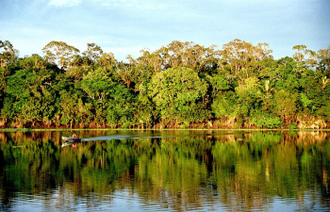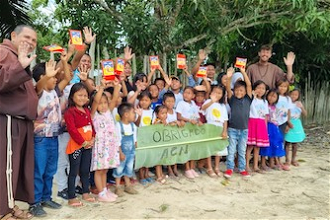Church forms new network to protect Amazon

Amazonia
A new international network formed to protect the Amazon gathered in Rome yesterday. The Pan-Amazon Ecclesial Network, established in 2014 in Brasilia, Brazil, consists of bishops whose territories include Amazon regions, priests, missionaries working in the Amazon jungle, national representatives of Caritas and laypeople belonging to various Church bodies.
The speakers were Cardinal Peter Kodwo Appiah Turkson, president of the Pontifical Council Justice and Peace Archbishop Pedro Ricardo Barreto Jimeno, SJ, of Huancayo, Peru and president of the Department of Justice and Solidarity of the Latin American Episcopal Council; Michel Roy, secretary general of Caritas Internationalis; and Mauricio Lopez Oropeza, executive secretary of REPAM. Cardinal Claudio Hummes, OFM, president of the Commission for Amazonia of the National Conference of Bishops of Brazil, was unable to be present but participated via an audio message.
The Amazon territory is the largest tropical forest in the world. It covers six million square kilometres and includes the territories of Guyana, Suriname and French Guyana, Venezuela, Ecuador, Colombia, Bolivia, Peru and Brazil. It is home to 2,779,478 indigenous people, comprising 390 indigenous tribes and 137 isolated (uncontacted) peoples with their valuable ancestral cultures, and 240 spoken languages belonging to 49 linguistic families.
As Archbishop Barreto explained, it is "a territory that is devastated and threatened by the concessions made by States to transnational corporations. Large-scale mining projects, monoculture and climate change place its lands and natural environment at great risk", leading to the destruction of cultures, undermining the self-determination of peoples and above all affronting Christ incarnate in the people who live there (indigenous and riparian peoples, peasant farmers, afro-descendants and urban populations).
REPAM was founded as "God's answer to this heartfelt and urgent need to care for the life of people so they are able to live in harmony with nature, starting from the widespread and varied presence of members and structures of the Church in Pan-Amazonia".
Cardinal Turkson illustrated the main characteristics of the network, starting with transnationality. "The large number of countries involved is due to the awareness that effective action to face challenges that cross the borders of a single State requires synergy between the living forces of all the nations involved, from the Secretariat of the REPAM to that of the dioceses and other Church initiatives in the various States, without forgetting that, from the beginning, the REPAM has worked in harmony with the Holy See, CELAM and its structures". Another key feature is ecclesiality: "as well as working transnationally, REPAM proposes the institution of harmonious collaboration between the various components of the Church: religious congregations, dioceses, Caritas, various Catholic associations and Foundations, and lay groups".
Commitment to the defence of life is, for Cardinal Turkson, the third characteristic. "REPAM was born in response to important challenges. It is engaged in defending the life of a number of communities who cumulatively comprise 30 million people. They are threatened by pollution, the radical and rapid change of the ecosystem upon which they depend, and the lack of protection for their basic human rights". He added that the network is presented in Rome not only on account of the symbolic value of the See of Peter, but also to give visibility to REPAM. "The form in which REPAM, acting as a platform, is structured and defines its working methods, its agenda, its allies or its methods of accreditation, could serve as a model for other local churches in other countries facing similar challenges.
In addition, REPAM has been conceived so as to become a tool that may be applied in different basic contexts, such as justice, legality, the promotion and protection of human rights; cooperation between the Church and public institutions at various levels; conflict prevention and management; research and spread of information; inclusive and equitable economic development; responsible and equitable use of natural resources, respecting Creation; and the preservation of the traditional cultures and ways of life of the different populations".
Cardinal Hummes, in his audio message, reiterated that the creation of the Pan-Amazon Ecclesial Network "represents a new incentive and relaunch of the work of the Church in Amazonia, strongly desired by the Holy Father.
There, the Church wishes to be, with courage and determination, a missionary Church, merciful, prophetic, and close to all the people, especially the poorest, the excluded, the discarded, the forgotten and wounded. A Church with an 'Amazonian face' and an 'native clergy', as Pope Francis proposed in his address to the bishops of Brazil".


















